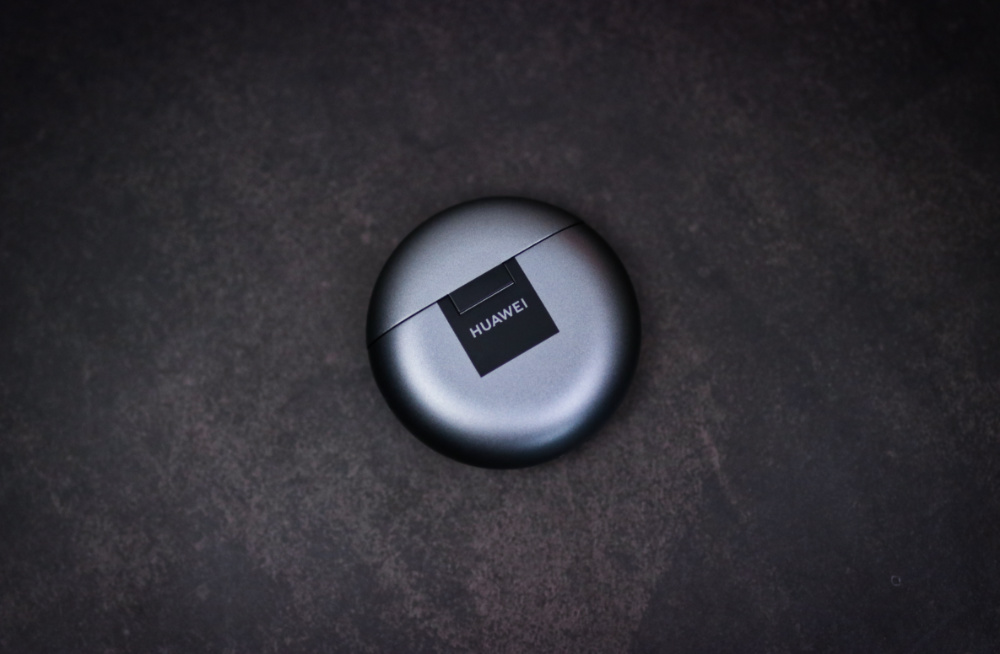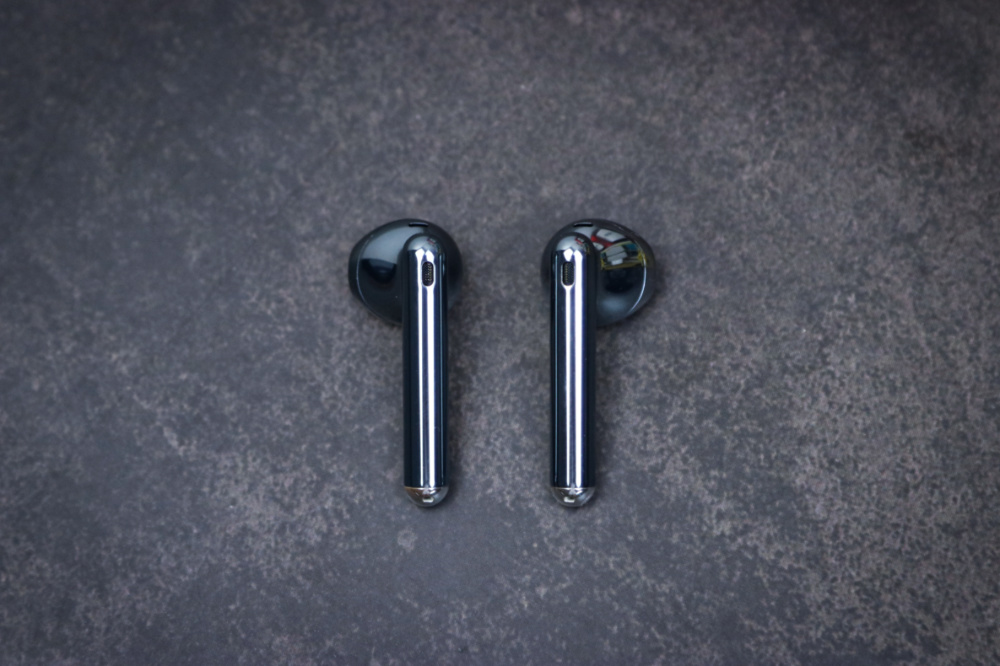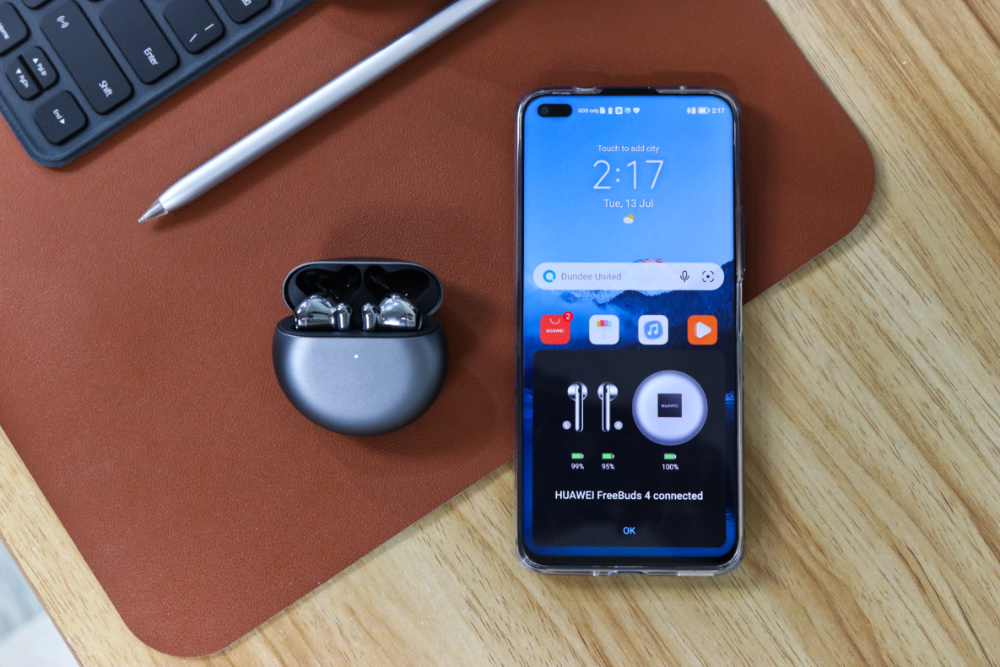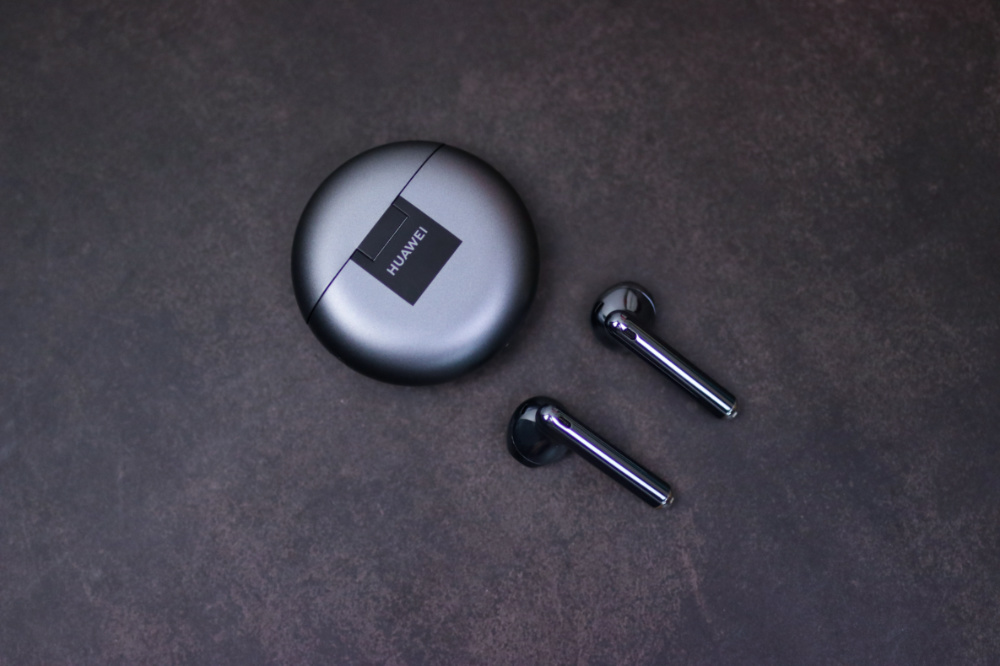Huawei is back with a new TWS earbuds with better audio, updated connections, and improved noise cancellation, the Huawei FreeBuds 4. It is the successor to the FreeBuds 3 from 2019. Is it a worthy upgrade? Find out in our hands-on.

One of the first things we noticed about the Huawei FreeBuds 4 is that it has a smaller case than the FreeBuds 3, although the battery capacity has remained the same. This is good in our books as it makes the device more pocketable.

It comes in two colors — Silver Frost and Ceramic White. What we have is the former, which we prefer given its matte texture and more professional look.

The case features an LED indicator on the front, while on the side is the pairing button.

Down below is the USB-C port for wired charging.

Open the case, and you’ll find the earbuds with a glossy metallic finish. Unfortunately, it’s a smudge and oil magnet. So, it’s going to look filthy if you don’t wipe it now and then.

The earbuds retain the Dolphin Bionic Design of the FreeBuds 3, although Huawei doesn’t mention that anymore in the FreeBuds 4.

The placement of the microphones and wear-detection sensors were retained. The external microphone on the FreeBuds 4 is bigger now, though, for better active noise canceling. We also noticed that the metal charging contact is now positioned at the bottom of the stem.

We like the fit of the FreeBuds 3, and we’re experiencing the same thing with the FreeBuds 4. It just slips easily and sits comfortably in the ears. The slim stem also makes it easy to adjust. It’s also light at 4.1g each and has IPX4 water resistance, meaning it can take on sweat, splashes of water, and rain.

Upon opening the case, the earbuds are already ready for pairing. If you own a Huawei device like a smartphone, MatePad, or MateBook, the FreeBuds 4 will appear on the screen. If you’re not using a Huawei device, you can do the traditional pairing method through Bluetooth settings.
The FreeBuds 4 uses Bluetooth 5.2 and supports dual connections. Meaning it can connect to two devices simultaneously. However, you can only listen to one audio source at a time. The purpose is for easy switching between devices, so you don’t have to go through the hassle of disconnecting and pairing again.

The FreeBuds 4 can be managed using the Huawei AI app. From here, you can access the connection center where it shows all the devices it has paired to; select sound quality for calls, including HD calls; adjust equalizer effects, toggle Noise-canceling, and NC mode; customize touch gestures so you can set what happens when you double-tap, press & hold, and swipe; activate Find My Earphones to emit a sound when it’s missing, and update the firmware.
Speaking of noise-canceling, the FreeBuds 4 is equipped with an Open-fit Active Noise Cancellation 2.0. It incorporates a new adaptive ear-matching technology to detect the in-ear shape and how you wear the earbuds, then intelligently selects from various noise cancellation modes to achieve optimal low-frequency sound reduction. It also has an open-fit design to allow air pressure to stay equalized so that important environmental sounds can still be heard for safer use.
We also noticed that you could no longer adjust noise-canceling levels on the FreeBuds 4, which is a feature available on the FreeBuds 3. Instead, you can pick between two NC modes: Cozy, for places with little noise, and General, for noisy places. Noise cancellation is not exactly as good as the ones you can experience on more expensive headphones that feel like they sucked the air out of a room. This one, instead, feels like you plugged your ears. Still good for blocking distracting noises, though.

The Huawei FreeBuds 4 is equipped with a large 14.3mm LCP dynamic driver in each earbud, which boasts a frequency range of up to 40kHz. Huawei didn’t disclose additional audio specifications, but based on our experience, these earbuds sound good. The mids and highs are clean and crisp. Female vocals are well emphasized, while high-pitched sounds are delivered with just the right amount of sibilance without becoming harsh. Lows are good as well, including male vocals can deliver powerful bass without becoming muddy.
We also like using it for voice calls as the microphones have good pick up. It is also capable of dual-mode 48 kHz HD sound recording with Surroundings and Voices Mode (for blocking out extraneous background noises), although we’re not sure how it is activated. As for latency, Huawei says that it has 90ms latency on HarmonyOS 2 phones and 150ms on EMUI phones. That’s weird considering other more affordable TWS earbuds can offer 65ms. Still, we didn’t experience any noticeable lag or delay when watching movies or playing games.

Each earbud has a 30mAh battery, while the charging case has a 410mAh battery. Playtime is up to 2.5 hours with ANC on and 4 hours with ANC off. With the help of the case, you can extend the playtime up to 14 hours with ANC and up to 22 hours with ANC off. Charging the earbuds takes about an hour while charging the case (without the earbuds) takes an hour as well. Sadly, there’s no wireless charging, but Huawei mentions on a support page the existence of a wireless charging edition.
The Huawei FreeBuds 4 has an SRP of PHP 7,999USD 136INR 11,555EUR 130CNY 993. But Huawei currently has a July sale promo where you can buy it for just PHP 5,999USD 102INR 8,666EUR 97CNY 744 from July 16 to 23, 2021, and comes with a free Bluetooth speaker. See link here.

YugaTech.com is the largest and longest-running technology site in the Philippines. Originally established in October 2002, the site was transformed into a full-fledged technology platform in 2005.
How to transfer, withdraw money from PayPal to GCash
Prices of Starlink satellite in the Philippines
Install Google GBox to Huawei smartphones
Pag-IBIG MP2 online application
How to check PhilHealth contributions online
How to find your SIM card serial number
Globe, PLDT, Converge, Sky: Unli fiber internet plans compared
10 biggest games in the Google Play Store
LTO periodic medical exam for 10-year licenses
Netflix codes to unlock hidden TV shows, movies
Apple, Asus, Cherry Mobile, Huawei, LG, Nokia, Oppo, Samsung, Sony, Vivo, Xiaomi, Lenovo, Infinix Mobile, Pocophone, Honor, iPhone, OnePlus, Tecno, Realme, HTC, Gionee, Kata, IQ00, Redmi, Razer, CloudFone, Motorola, Panasonic, TCL, Wiko
Best Android smartphones between PHP 20,000 - 25,000
Smartphones under PHP 10,000 in the Philippines
Smartphones under PHP 12K Philippines
Best smartphones for kids under PHP 7,000
Smartphones under PHP 15,000 in the Philippines
Best Android smartphones between PHP 15,000 - 20,000
Smartphones under PHP 20,000 in the Philippines
Most affordable 5G phones in the Philippines under PHP 20K
5G smartphones in the Philippines under PHP 16K
Smartphone pricelist Philippines 2024
Smartphone pricelist Philippines 2023
Smartphone pricelist Philippines 2022
Smartphone pricelist Philippines 2021
Smartphone pricelist Philippines 2020